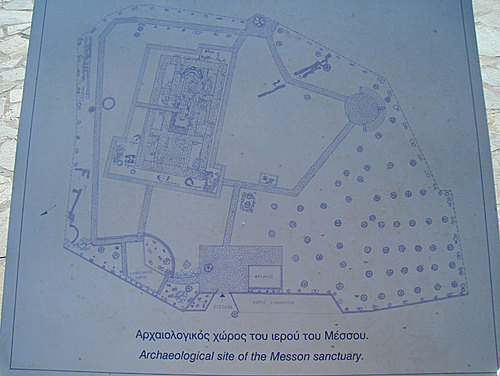Sanctuary of the three gods, Messon, Lesbos
Archaeological Development
The first mention of the Sanctuary of the Three Gods at Messon was by the French traveller M. Boutan in 1855, while the German R. Koldewey conducted the first excavations in December 1885 and January 1886. Subsequent excavations were made in the period from 1965 to 1967 by B. Petrakos, collecting scattered fragments in the area of the sanctuary and the wider area of the Gulf of Kalloni. The culmination of the archaeological investigation of the site at Messon came with the work of the 20th Ephorate of Prehistoric and Classical Antiquities, under the supervision of the General Directorate of Antiquities & Cultural Heritage, who facilitated the re-emergence and renovation of the original Temple to the Three Gods, their work spanning the period from 2000-2006. The archaeological site is now open daily to the public (except for Mondays) and there is a museum nearby displaying parts of the Temple architecture.
Shrine is an Ionic-style temple (unique amongst architecture from Greek territories), consisting of eight marble columns enclosing an area 41.55m by 23.78m. A small wooden amphitheatre was located in the south-east corner of the site with a seating capacity of around 200.
Gods/Heroes
- Zeus as "God of Suppliants."
- Dionysus Omastes ("Eater of Raw flesh")
- An Aeolian Mother goddess, precise identity unclear, commonly linked with Hera but occasionally with Cybele, a Mother goddess whose worship originated in Anatolia.
Ritual Activity
- Cult and dedications to each of the Three gods, as evidenced by the recovery of sacrificial altars, though due to the sanctuary’s history of being destroyed and converted several times throughout its history little remains of the original offerings.
- Performance of poetry - e.g. the poems of Sappho:
- The Charaxos Song.
- The Cypris Song.
- The Brothers Song.
- Beauty pageants (often conducted in honour of Hera), as well as rites for women involving sacred ululation.
- Festivals:
- The Callisteia – Celebrated Lesbos’ federation under Mytilene c. 7th Century. Involved contests of beauty and choral choirs.
- A festival named “Days for turning around the Middle” as noted by Alcaeus.
Rules and Regulations
-
Some rituals, particularly in the case of the cults to Dionysus and the Mother Goddess, were for women only, for example beauty pageants, as well as rites involving sacred ululation.
- The sanctuary at Messon constituted a "middle" ground of political neutrality.
Other Activities
- Was the seat of the Federation of Lesbian Poleis, where assemblies and councils met to discuss issues of the day. Federal law cases were also tried on the site – e.g. when judges from Miletus were called to resolve a dispute between Methymna and Eresos in the 2nd century B.C.
- The Sanctuary of the Three Gods served as a “middle” ground of political neutrality, thus during times of stress it became a place where negotiations would be discussed.
- Cultural events took place at the amphitheatre.
- Due to its importance, and the consequent popularity with the populace, the shrine was a centre of communication on Lesbos.
Historical Significance
Shrine to the Three Gods established at Messon c. 7th Century B.C., supposedly by the Achaean-Aeolians upon their first arrival at Lesbos. Widely considered by ancient and modern scholars to be the most important sanctuary on Lesbos.
One legend states that the Apostle Paul came to Messon in 52 A. D. to preach Christianity to the inhabitants of Lesbos.
The sanctuary continued its pagan practices up until C. 4th Century A.D., when the sanctuary was destroyed and converted into a Christian Basilica and accompanying cemetery, the archaeology suggesting that the marble from the original shrine was actually broken down and utilised as mortar for the construction of these later structures, thus implying that the shrine's pagan significance was such that it could only be subdued by Christianity by way of demolishing it completely and supplanting it with a structure of Christian significance.
During the latter years of the Byzantine Period the site was again converted into a small temple for the worship of Taxiarchis (i.e. the Archangel Michael), a worship which continues to this day on the same site.
Who used the site, and where did they come from?
The majority of the inhabitants of Lesbos.
Select Site Bibliography
Primary Sources
-
Sappho, Alcaeus, Greek Lyric, Volume I: Sappho and Alcaeus, trans. D. A. Campbell (London: Harvard University Press 1982)
Secondary Sources
- Calame, C., (2001), Choruses of Young Women in Ancient Greece (Maryland: Rowman and Littleford Publishers, Inc.)
-
Cole, S. G., (2004), Landscapes, Gender, and Ritual Space: The Ancient Greek Experience (Berkeley: University of California Press)
-
Obbink, D. (2016), 'The Newest Sappho: Text, Apparatus Criticus, and Translation,' in The Newest Sappho: P. Sapph. Obbink and P. GC inv. 105, frs. 1–4, Studies in Archaic and Classical Greek Song, vol. 2, ed. A. Bierl and A. Lardinois (Leiden: Brill Press)
- Quinn, J. D. (1961), 'Cape Phokas, Lesbos-Site of an Archaic Sanctuary for Zeus, Hera and Dionysus?' American Journal of Archaeology, 65: 391-393
Internet sources
- D. Tsolakis, I. Kourtzellis, Archaeological Report - http://odysseus.culture.gr/h/3/gh351.jsp?obj_id=2560, accessed 10/4/17
- http://archive.fo/fpZV, accessed 11/4/17
- http://www.lesvosgreece.gr/en/areas-archaeological-interest, accessed 11/4/17
- http://www.zeus.guide/lesvos-travel-guide/e-lesvos-the-central-south-of-the-island-plomari-polichnitos-west-from-kerameia-to-polichnitos-vatera-the-sanctuary-of-mesa, accessed 10/4/17
- Princeton Encyclopaedia of Classical Sites - Lesbos - http://www.perseus.tufts.edu/hopper/text?doc=Perseus:text:1999.04.0006:entry=lesbos&highlight=shrine%2Clesbos, accessed 10/4/17
Location
9km southeast of Agia Paraskevi and just 800 meters away from the National Road (direction Mytilene).
The use of the term “Messon” to describe the location of the sanctuary comes from the Greek term meaning “middle/centre,” referencing the fact that the sanctuary is located near enough to the geographical centre of the island.
Site Plan

